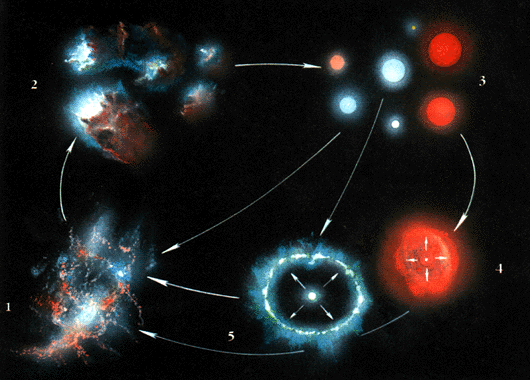
The gas and dust circulation
The gas and dust circulation in the Universe.
In the interstar space the gas and the dust is unevenly spread, concentrating into the clouds and surclouds. The superclouds size is several hundred parsec and a typical mass is the several million Sun's mass. Mainly they are the long nuclear neutral hydrogen areas. There also embedded more compact giant molecula clouds in them where presents practically all molecular gas i.e. about the half of all interspace gas in Galaxy (2 billion Sun's mass).
The interstar gas serves a material for the new stars formation. The hard clasters - the future body embryons are formed in the gas cloud under the gravity force. This cluster continues to compress up to the moment when in its centre the temperature and the density is so high that the thermonuclear reactions will begin turning hydrogen into helium. From that moment the gas cluster becomes a stars.
The interstar dust also takes part in the stars formation. The dust helps to the more rapid gas cooling off. It absorbs the energy escaping during the callapse (compression) of a protostar cloud, then reradiate it in the other spectrum ranges, influencing the energy change between ranges, influencing the energy change between the new star being given birth and the environment. It depends on the character of this change, its properties and the amount of the dust in the cloud how many stars will be formed and their mass.
If the stars are generated in some part of a dense molecular cloud, their influence on the gas may accelarate the condensation of the nearest gas clouds and arise the star formation in them, - the chain reaction of star formation goes. The starformation in the molecular clouds may be comparedwith the fire. It begings in one part of a cloud then comes to the other parts taking the interstar gas and turning it into stars.
The hydrogen in the centre of the star "burns out" turning into helium. the core begings to compress and the sxternal layers expand. In the definite period of evolution the star takes of its shell or even bursts as a new one, returning the gas used for its formation into the interstar medium.
The flying shell captured the interstar gas and increases its temperature to the hundred thousand degrees. Cooling off this gas generates the fibrous nebulas, increasing with the velocity of hundred kilomiters a second. In hundred thousand years the remain of this substance is braked and dispersed in the interstar medium, and after some time it may come into a new young star composition again.
After thermonuclear reaction in the depths of a massive star not only helium generates but other chemical elements. Together with the flying away shell they get into interstar gas. That's why the gas which has gone through the nuclear reactor of a star is rich with the chemical elements. The stars were born and died in the Galaxy in the course of many billions years. And practically all the gas, which now presents in the interstar medium has many times come through the nuclear reactor.
Eirlier the gas has no dust. It appeared with the stars getting older. These stars are the red giants which have a cold shell. All this temperature in the atmosphere the stars generate the particles of dust. The star radiation blows these particles into interstar space, where they changed with the interstar gas. The red giant soils the space with the dust.

The gas and dust circulation
1 - rarefied clouds of the interstar gas; 2 - the cold molecular clouds; 3 - the stars of different mass and luminance; 4 - putting of the shell by the red giant; 5 - the burst of supernew star. During the three last stages the masses of the stars come back to the interstar medium as a rarefied gas.